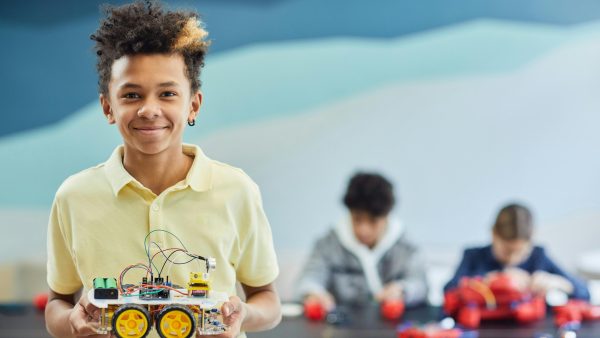This is shown in the “Study on the use of technology in education” carried out by Ipsos for Telefónica Empresas, where 99 percent of the management of the educational centres questioned consider that technology helps teaching quite a lot (56%) or a great deal (43%). In other words, 99 per cent agree.
This unanimity extends to the teaching staff. 62 percent say technology helps a great deal, 27 percent say it helps a lot and only 2 percent say it hinders, while 9 out of 100 say it neither helps nor hinders.
Asked about this issue too, families are also clear: 83 per cent are in favour of technology – 57 per cent say it helps enough and 26 per cent say it helps a lot – compared to 13 per cent who say it neither helps nor hinders and 4 per cent who say it hinders a lot.
The “Study on the use of technology in education” was attended by representatives of the seventeen Education Departments, headmasters, teachers and families with children from primary, secondary, baccalaureate and vocational training schools.
Multiple benefits
The report shows a clearly positive response to the introduction of technology in education, and its many benefits.
Thus, among the many advantages highlighted by school management is that technology facilitates the introduction of new methodologies (for 97%), helps to have a greater number of educational resources (96%) and facilitates the involvement of pupils (95%).
The same line is taken by the teaching staff, with minor differences. For 88 per cent it helps to have more resources, while 83 per cent say it facilitates new technologies.
The family group has the lowest percentage in favour, although it is far from being the majority. 79% agree or strongly agree that technology helps to make more educational resources available, and 58% say it also makes it easier for parents to be involved in their children’s education.
In contrast, only 39 per cent of school management and teachers say that technology creates a digital divide in the classroom, a percentage that drops to 34 per cent of families.
Internet, the main resource
When it comes to which digital teaching resources are most used, we again find a clear unanimity: the Internet is the main source of teaching resources, together with self-developed ones.
For management, the internet resource has a 96 percent approval rating, compared to 79 percent for teachers, while the self-developed ones have 91 percent and 72 percent support, respectively.
Another advantage of the use of new technologies in education that is reflected in this study for Telefónica Empresas is that it favours greater collaboration between the educational community, even if this means a certain overload of work, which the company is able to do better with its students.
Both management, teachers and families are clear that the arrival of technology in the classroom means that classes are more motivating for pupils and that they contribute to educating them in today’s world.
Digitised centres
The study also looks at the degree of digitisation of educational centres, where the average score of management and teaching staff remains above 7, on a scale of 1 to 10.
In terms of sections, the note on connectivity stands out, rated 7.55 by the management and 6.38 by the teaching staff. Both groups followed with 7.49 and 6.21, respectively, for pedagogical content.
On the low side, equipment and software are the areas mentioned as having the most room for improvement.
Needs
Managers and teachers agree on what needs to be improved as part of the move towards a more digitalised education. In particular, they point to three areas for improvement, namely hybrid classrooms, integrated management services and robotic automation software.
The three levels of the education system are committed to a mixed system in which face-to-face education is supported by hybrid materials, i.e. both physical and digital.
For all this new digital era, investment in classroom equipment – electronic whiteboards, projectors, computers, etc. – is necessary, an issue on which management (51%), teachers (52%) and families (45%) agree.
To a greater or lesser extent, they are missing individual devices, especially steering (55%), as well as more connectivity or software.
What they also agree on is the need for more training for students, teachers and parents to learn digital skills.
Digital transformation
Schools are aware of the new digital era, and many of them already have a plan for their digital transformation. According to the study, more than half of the schools have such a plan, either through their own budget or through European funds.
To this end, two out of every school head recognise that it is “interesting” to have a single service provider. When asked if they would consider using Telefónica Empresas and some of its technology partners to cover the needs of their educational centre, the response is clearly favourable, with 82 percent.
In fact, 26% of school management said they would consider it safe to use this company, while 56% said they probably would, compared to only 11% who said they probably would not.
Finally, 75 percent of teachers consider it interesting for technology companies to work together to promote the digitisation of education, a percentage that rises to 81 percent when families are asked.
It is clear that all levels of the education system are aware of all the advantages of the digital transformation in the classroom, an irreversible process after the pandemic, in favour of a model that will be more inclusive, with greater collaboration from the educational community, an increase in resources and a more enjoyable and entertaining system for the student.










